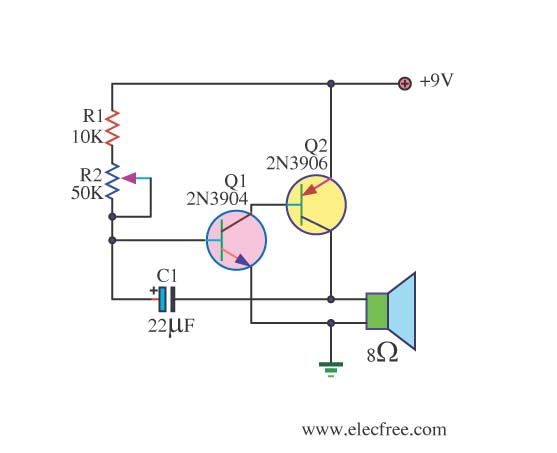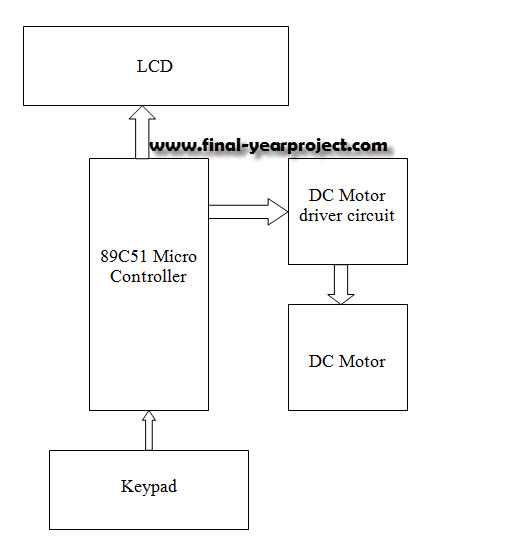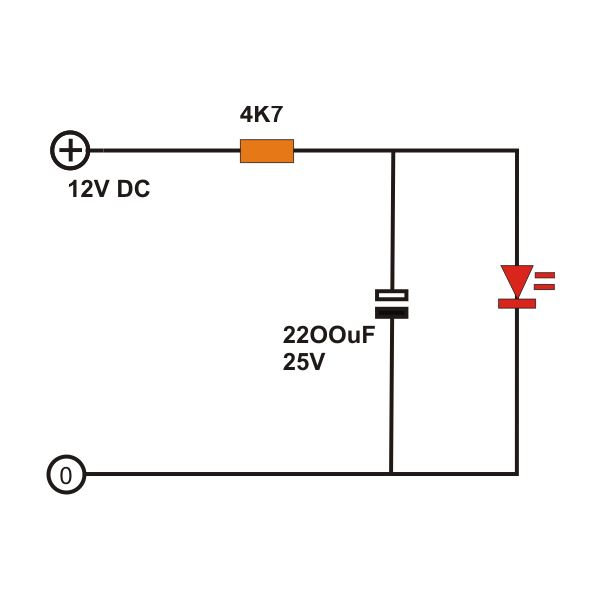
Simple Metronome using transistor

This circuit is a simple metronome model designed for ease of use. It employs transistors as key components, specifically configured as an astable multivibrator, to produce a beeping sound. The tone can be adjusted using a variable resistor (VR1). A loudspeaker with an impedance of 8 to 32 ohms is recommended. The circuit features a microphone amplifier, which is modified with a 10 µF capacitor.
The design generates both light and sound signals, making it suitable for applications such as bicycle taillights or turn signals. The power supply circuit includes two transistors, Q1 and Q2, functioning as an astable multivibrator that continuously toggles between ON and OFF states. The collector pins (C) of both transistors are connected to a light source (LED1-LED4) and an audio source (buzzer BZ1). When one transistor is ON, the associated device connected to pin C operates, producing alternating light and sound signals.
The circuit generates a melody by employing a flasher circuit that activates a loudspeaker with a clicking sound. The PNP transistor (Q2, options include 2N3906, 2N2907, or BC558) operates based on the circuit's frequency, determined by the resistor-capacitor (RC) combination and the NPN transistor (Q1, options include 2N3904, 2N2222, or BC549). A 50K potentiometer (R2) is used to fine-tune the working rate, which can vary from 20 to 280 beats per minute (bpm). By changing the value of capacitor C1 (from 0.1 µF to 22 µF), the pitch of the sound produced can be altered. Higher-pitched tones can be achieved by using smaller capacitors, while adjusting a 10K resistor from fixed to variable can increase the voltage supplied to the circuit, although this may risk overheating or damaging the transistors.
The circuit has been tested with components including a 2N3904 transistor, a 2N3906 transistor, a 22 µF capacitor, a 10K resistor, a 50K trimmer resistor, and a piezo transducer. The necessity of a loudspeaker is contingent on the desired output sound quality and application.
The schematic for this metronome circuit should include the following components arranged as follows:
1. **Transistors**:
- Q1: NPN (e.g., 2N3904)
- Q2: PNP (e.g., 2N3906)
2. **Resistors**:
- R1: Fixed resistor (value as per design requirement)
- R2: 50K potentiometer for rate adjustment
- R3: 10K resistor (can be variable)
3. **Capacitors**:
- C1: Adjustable between 0.1 µF and 22 µF for tone variation
- C2: 10 µF for amplification adjustments
4. **Output Devices**:
- LEDs (LED1-LED4) for visual indication
- Buzzer (BZ1) for audio output
- Optional: Piezo transducer for sound generation
5. **Power Supply**:
- Ensure appropriate voltage supply to support transistor operation.
The circuit layout should clearly depict the connections between components, ensuring that the collector, base, and emitter of each transistor are correctly positioned for optimal functionality. The variable components should be labeled to facilitate adjustments during testing and operation.This circuit be Simple Metronome circuit model to be simple. It use the transistor be important equipment by very the circuit is the character Astable Multi vibrator. For produce something the sound beep. By can fine VR1 for get sound tone Generator follow can want. A loudspeaker that use to is supposed to impedance 8 32 ohm railing land. For decrease the popularity will down and may lead, output, go to feed reach still the amplifier microphone has changed, capacitors 10 uF. The detail is other, see in the circuit. This circuit is a simple signal. It can generate signals, both light and sound Alternating. Which can be applied to work. For example Taillight of bicycle or Turn left and the right of the bicycle. Etc. When entering into power supply circuit. by circuit will have Q1 and Q2 to be astable multi vibrator. This will work in any way ON and OFF. Or vice versa on all the time. And Pin Collection (C) of the two transistors. Connected to the light source device (LED1-LED4). For the audio source device is Buzzer BZ1. While the one ON transistor will allow the device is connected to pin C is running. The signal alternates between light and sound all the time. This is knock the melody. It uses begin flasher circuit in building sound click keen go up at a loudspeaker. But each time at PNP-transistor, Q2 type(2N3906-2N2907-or-BC558) work by origin frequency circuit that use RC and Q1-NPN transistor-type(2N3904 or 2N2222-or BC549), R2-potentiometer 50K is used for fine working rate repeatedly through 20-280 sections time per minute(tone), By value change of C1 (0.
1uF to 22uF) will change the tone of voice in the sound click at happens. You can get different (i. e. higher pitched) tones by messing with the capacitor value from 22uF to. 1uF electrolytics, and whatever other capacitors you may have in your parts box. By changing the 10K resistor from fixed to variable, you can increase the voltage going to the circuit, but at the risk of the transistors failing via overheating/overvoltage. I could not get mine to work. I was using a breadboard, 1 2N3904, 1 2N3906 and 22 uF capacitor and 1 10 k resistor and 50k trimmer resistor.
And a piezo transducer. Do I really need a speaker 🔗 External reference
The design generates both light and sound signals, making it suitable for applications such as bicycle taillights or turn signals. The power supply circuit includes two transistors, Q1 and Q2, functioning as an astable multivibrator that continuously toggles between ON and OFF states. The collector pins (C) of both transistors are connected to a light source (LED1-LED4) and an audio source (buzzer BZ1). When one transistor is ON, the associated device connected to pin C operates, producing alternating light and sound signals.
The circuit generates a melody by employing a flasher circuit that activates a loudspeaker with a clicking sound. The PNP transistor (Q2, options include 2N3906, 2N2907, or BC558) operates based on the circuit's frequency, determined by the resistor-capacitor (RC) combination and the NPN transistor (Q1, options include 2N3904, 2N2222, or BC549). A 50K potentiometer (R2) is used to fine-tune the working rate, which can vary from 20 to 280 beats per minute (bpm). By changing the value of capacitor C1 (from 0.1 µF to 22 µF), the pitch of the sound produced can be altered. Higher-pitched tones can be achieved by using smaller capacitors, while adjusting a 10K resistor from fixed to variable can increase the voltage supplied to the circuit, although this may risk overheating or damaging the transistors.
The circuit has been tested with components including a 2N3904 transistor, a 2N3906 transistor, a 22 µF capacitor, a 10K resistor, a 50K trimmer resistor, and a piezo transducer. The necessity of a loudspeaker is contingent on the desired output sound quality and application.
The schematic for this metronome circuit should include the following components arranged as follows:
1. **Transistors**:
- Q1: NPN (e.g., 2N3904)
- Q2: PNP (e.g., 2N3906)
2. **Resistors**:
- R1: Fixed resistor (value as per design requirement)
- R2: 50K potentiometer for rate adjustment
- R3: 10K resistor (can be variable)
3. **Capacitors**:
- C1: Adjustable between 0.1 µF and 22 µF for tone variation
- C2: 10 µF for amplification adjustments
4. **Output Devices**:
- LEDs (LED1-LED4) for visual indication
- Buzzer (BZ1) for audio output
- Optional: Piezo transducer for sound generation
5. **Power Supply**:
- Ensure appropriate voltage supply to support transistor operation.
The circuit layout should clearly depict the connections between components, ensuring that the collector, base, and emitter of each transistor are correctly positioned for optimal functionality. The variable components should be labeled to facilitate adjustments during testing and operation.This circuit be Simple Metronome circuit model to be simple. It use the transistor be important equipment by very the circuit is the character Astable Multi vibrator. For produce something the sound beep. By can fine VR1 for get sound tone Generator follow can want. A loudspeaker that use to is supposed to impedance 8 32 ohm railing land. For decrease the popularity will down and may lead, output, go to feed reach still the amplifier microphone has changed, capacitors 10 uF. The detail is other, see in the circuit. This circuit is a simple signal. It can generate signals, both light and sound Alternating. Which can be applied to work. For example Taillight of bicycle or Turn left and the right of the bicycle. Etc. When entering into power supply circuit. by circuit will have Q1 and Q2 to be astable multi vibrator. This will work in any way ON and OFF. Or vice versa on all the time. And Pin Collection (C) of the two transistors. Connected to the light source device (LED1-LED4). For the audio source device is Buzzer BZ1. While the one ON transistor will allow the device is connected to pin C is running. The signal alternates between light and sound all the time. This is knock the melody. It uses begin flasher circuit in building sound click keen go up at a loudspeaker. But each time at PNP-transistor, Q2 type(2N3906-2N2907-or-BC558) work by origin frequency circuit that use RC and Q1-NPN transistor-type(2N3904 or 2N2222-or BC549), R2-potentiometer 50K is used for fine working rate repeatedly through 20-280 sections time per minute(tone), By value change of C1 (0.
1uF to 22uF) will change the tone of voice in the sound click at happens. You can get different (i. e. higher pitched) tones by messing with the capacitor value from 22uF to. 1uF electrolytics, and whatever other capacitors you may have in your parts box. By changing the 10K resistor from fixed to variable, you can increase the voltage going to the circuit, but at the risk of the transistors failing via overheating/overvoltage. I could not get mine to work. I was using a breadboard, 1 2N3904, 1 2N3906 and 22 uF capacitor and 1 10 k resistor and 50k trimmer resistor.
And a piezo transducer. Do I really need a speaker 🔗 External reference
Warning: include(partials/cookie-banner.php): Failed to open stream: Permission denied in /var/www/html/nextgr/view-circuit.php on line 713
Warning: include(): Failed opening 'partials/cookie-banner.php' for inclusion (include_path='.:/usr/share/php') in /var/www/html/nextgr/view-circuit.php on line 713





